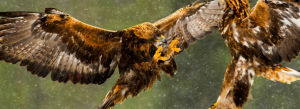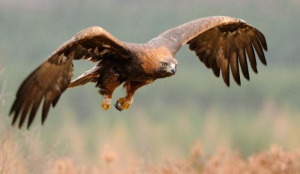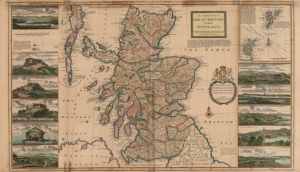
GOLDEN EAGLES ARE EPIC
Do you know what the national animal of Mexico is? Why it’s the golden eagle! The genus name is aquila chrysaetos meaning “eagle, golden eagle”. The golden eagle is a close relative of the American bald eagle. Recognized by its broader wings and smaller head, the golden eagle has high yelping calls, and with its dark brown and golden plumage, this raptor is known to be a symbol of fear and reverence, and holds mystical powers in the eyes of the Native Americans. Although the golden eagle is spoken of in legends, many people still don’t know too much about this bird of prey. This is because the golden eagle prefers to live in places with little human activity. Golden eagles also have large territories where they conduct their activities, and they have many physical and mental abilities which make them far superior to other raptors.
The golden eagle is a very peculiar raptor, because its activities have rarely been documented. These birds are found mostly in western North America, past the Rocky Mountains, and can be found in habitats from the arctic regions to the desert. Their territories stretch to sixty square miles, and squirrel-sized mammals, to foxes and young ungulates (hoofed animals), are what they eat; the golden eagle swoops down on its unsuspecting prey, talons grabbing, lifting into the sky. Even though golden eagles can live in a variety of habitats, they prefer wide-open places. 
If a rival eagle flies too close to another eagle’s territory, the home eagle will defend his territory through the use of acrobatics to send a message that tells the intruding one: “This is my territory.” Golden eagles are monogamous, building large nests that grow bigger and bigger every season. This often results in the mated pair adding new layers and materials such as moss, grass, weeds, and local vegetation. Golden eagle nests average five to six feet wide and 2’ in height. Golden eagles often build their nests on cliff ledges, but seldom in lofty trees as most raptors do; while both provide commanding views, one could argue that the golden eagle prefers the solid berth of the stones and their disassociation from other tall objects. In the nest, the female will lay 1-4 eggs. These eggs are white, marked with brown. After 41-45 days of incubation, tiny eaglets hatch from the eggs. However, only one or two of them will survive until the fledgling stage. The surviving eaglet or eaglets will have their first flight, 60 to 70 days after hatching.
The golden eagle uses many different techniques to hunt, soaring over its land, and scanning the ground for animals, or flying low over the ground to hunt. Another form of hunting that golden eagles use is perch hunting. This is when the eagle is perched on a branch and scans the area underneath him for prey. Upon seeing prey, the golden eagle swoops down and attacks it by diving with talons outstretched. Golden eagles, like many birds of prey use their talons to catch prey. However, unlike its endangered fish-eating relative the bald eagle, the golden eagle’s legs are feathered all the way down to the talons. Some may argue that golden eagles have feathered feet because of what they eat, as if eating hairy animals puts hair on a birds’ legs. Well, the bald eagle and other sea eagles have bare legs, perhaps because they eat fish, and don’t want to get waterlogged.

Golden eagles have a 6.7 to seven foot-long wingspan, quite large for a raptor. They use their wings to perform flight patterns in the air to defend territory and to court. Often in courtship, two golden eagles can be seen circling each other, rather than engaged in the vigorous swoops and climbs used while defending territory. These flight patterns are always used to send a message whether it is: “I like you” or “You Shall Not Pass!”
Many people also wonder why the female golden eagle is larger than the male. This difference in size is through reverse sexual dimorphism, which is the difference in appearance between males and females of the same species. In most species, the male is larger, or more decorated, than the female, which can be seen in peacocks where the male has a more elaborate decoration than the female. However, female golden eagles are larger than males, thus showing us an example of reverse sexual dimorphism. The female golden eagle often weighs 40% more than a male and has a 10% larger wingspan than males.
There have been many theories about reverse sexual dimorphism in birds of prey, especially in eagles, hawks, and owls. One such theory on why the male is smaller than the female is: the smaller the male, the faster it can hunt and forage. This is mainly based on the fact that female raptors often stay protecting and incubating the nest, while males go out to hunt and feed the female as she incubates. Another theory is that reverse sexual dimorphism is an adaptation, and the larger female eats/takes down larger prey compared to the male. This adaptation is to expand the variety of food the pair eats; which would greatly help in times of scarce food because it wouldn’t matter what prey they caught.
Many other raptor species also have reverse sexual dimorphism. Hawks, owls, falcons, and other subspecies all have a larger female than a male. However, there are a few exceptions like the burrowing owl (athene cunicularia), where the male is slightly larger than the female. The difference in size between male and female also varies from species. Scientists have speculated that it has to do with their diets. Birds that hunt large prey, like the golden eagle, have more sexual dimorphism compared to birds that prey on smaller insects and birds. So, more aggressive bird species have more sexual dimorphism. Eleanora’s Falcon shows very little sexual dimorphism compared to other bird species like the golden eagle, because it preys on small birds that often don’t fight back. The golden eagle on the other hand, often preys on larger prey like squirrels and foxes. Foxes tend to be more aggressive, and there is a large predator to prey ratio when hunted by the golden eagle. Now, is it because the males are already geared for being adept killers, but the females need a booster, so to speak, to get down and dirty with clawing apart prey?

The golden eagle has had a significant role in many cultures, past and present. The Native Americans perform rituals with golden eagle feathers, and used to wear the feathers into battle. In Europe and Asia, ancient kings used to hunt with eagles. The golden eagle was also highly revered in ancient Greek and Roman cultures. They believed that the eagle was a messenger of the gods, and it was a symbol of Zeus/Jupiter. The golden eagle was also the model for the ‘aquila’ a symbol of Rome, and army campsites were placed near their nests if spotted. Nowadays, the golden eagle is the national bird in seven countries and used in the coat of arms or other symbols as well. Hunting with eagles is now mainly practiced in Central Asia. Aquila Chrysaetos is now the national symbol of five countries: Albania, Germany, Austria, Mexico, and Kazakhstan.
The golden eagle has also been misused by certain parties and countries. The Third Reich, for example, selected the golden eagle to be part of their “The Reichsadler,” a Nazi symbol with a golden eagle perched upon the Nazi swastika. Arguing against adopting the Golden Eagle as the National Bird of Scotland, the deputy leader of the Tories in Scotland complained that, “the symbol was the last thing that victims saw as they were herded into Nazi death camps.” However, why should the bird be condemned to this bloody, painful symbolism? “It’s hailed as an icon of wild Scotland, used on company logos, place names and ancient burial sites, and now a new campaign is aiming to see the golden eagle named as the country’s national bird.” This is language from a petition submitted to the Scottish Parliament in 2014.
“There are currently just 431 pairs of Golden Eagles in the whole of Scotland. Owing to centuries of persecution, this most charismatic of birds has been almost entirely confined to the more remote areas of the country, such as the mountains and glens of the west coast and on the western isles, with numbers held at artificially low levels and many territories vacant.”
“RSPB Scotland, backed by wildlife cameraman Gordon Buchanan, has submitted a petition urging ministers to formally designate the species as a national symbol, placing it alongside the lion rampant, saltire and Scottish thistle and emblems of the country.”
Through these depictions, the golden eagle’s reputation as a fierce predator has been exploited for negative purposes, unlike the more reverent symbolism in ancient Greek, Roman, and North American culture. The golden eagle is a bird recognized by its predatory abilities, and ferocity. They reside in very remote places in this world, and are revered by many cultures, past and present. So the next time you are out traveling the world, try and notice eagle symbolism around the area; if you see any, lift your gaze to the skies or the nearest rocky cliff.
